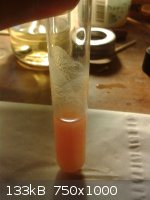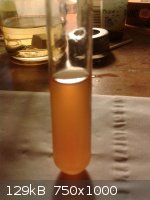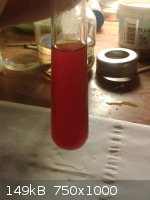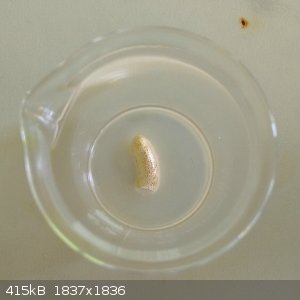| Pages:
1
2 |
redox
Hazard to Others
  
Posts: 268
Registered: 22-2-2011
Location: The Land of Milk and Honey
Member Is Offline
Mood: Chalcogenetic
|
|
Acetone and Alkali Metals
If this topic has all ready been discussed, please forgive my ignorance.
__________
Hello,
Recently, I was experimenting with my alkali metals (specifically lithium), and I decided to drop a wad of lithium into acetone. A vigorous reaction
ensued, and an orange compound manifested itself on my precious lithium.  I
have researched this reaction and I could not find a reference to it. I
have researched this reaction and I could not find a reference to it.
What could be happening? Would this orange substance be an exceptionally strong base (on account of acetone's extremely low acidity)? What is the name
of this compound?
Thanks.
[Edited on 31-5-2011 by redox]
My quite small but growing Youtube Channel: http://www.youtube.com/user/RealChemLabs
Newest video: Synthesis of Chloroform
The difference between chemists and chemical engineers: Chemists use test tubes, chemical engineers use buckets. |
|
|
UKnowNotWatUDo
Hazard to Self
 
Posts: 96
Registered: 30-6-2010
Member Is Offline
Mood: No Mood
|
|
There are three possibilities. One: the lithium reduced the acetone forming lithium isopropoxide. But seeing as that compound is white (IIRC) I doubt
it. Two: the lithium removed an alpha-hydrogen forming hydrogen gas and the lithium salt of acetone enolate. But I think that is also white, not
orange. Three: the lithium reacted with some impurities in the acetone.
|
|
|
Sedit
International Hazard
    
Posts: 1939
Registered: 23-11-2008
Member Is Offline
Mood: Manic Expressive
|
|
I would think your seeing latent water leading to a base catalyzed Aldol reaction forming a brown polymer film on the surface of the lithium.
Knowledge is useless to useless people...
"I see a lot of patterns in our behavior as a nation that parallel a lot of other historical processes. The fall of Rome, the fall of Germany — the
fall of the ruling country, the people who think they can do whatever they want without anybody else's consent. I've seen this story
before."~Maynard James Keenan
|
|
|
redox
Hazard to Others
  
Posts: 268
Registered: 22-2-2011
Location: The Land of Milk and Honey
Member Is Offline
Mood: Chalcogenetic
|
|
The presence of latent water is very likely, as my acetone was hardware-store grade.
I asked my father (the organic chemist) and he said there was a possibility that the reaction formed lithium acetonate. Looking at the structure of
the acetonate ion, it seems it is just acetone enolate with another methyl ketone group on one of the hydrogens.
Sedit, maybe the polymer was a chain of acetone enolates with more methyl ketone groups, making a polymer of structure = [CH(Li)CO]n
Is the formation of lithium acetonate a possiblity?
[Edited on 31-5-2011 by redox]
My quite small but growing Youtube Channel: http://www.youtube.com/user/RealChemLabs
Newest video: Synthesis of Chloroform
The difference between chemists and chemical engineers: Chemists use test tubes, chemical engineers use buckets. |
|
|
woelen
Super Administrator
        
Posts: 8080
Registered: 20-8-2005
Location: Netherlands
Member Is Offline
Mood: interested
|
|
I have done this experiment as well, using sodium instead of lithium. I used distilled acetone of high purity, although still some water might have
been in the acetone. The reaction was vigorous but not violent. All of the sodium dissolved and I obtained a yellow/brown insoluble slurry in the
acetone.
I am inclined to think that the acetone molecules simply are broken into pieces and that these rearrange to form some insoluble polymeric compound of
ill-defined composition.
A similar experience I had with adding conc. H2SO4 to pure acetone. Immediately after adding the acid and swirling well, the liquid is colorless, but
it slowly turns yellow, orange, red, red/brown and finally almost black. The liquid also turned more viscous. This reaction takes many hours. Again, I
think that acetone molecules are broken down somewhat and some polymeric species is formed and with increasing molecular size the color of this
species intensified.
|
|
|
ScienceSquirrel
International Hazard
    
Posts: 1863
Registered: 18-6-2008
Location: Brittany
Member Is Offline
Mood: Dogs are pets but cats are little furry humans with four feet and self determination! 
|
|
I think that aldol type condensations occur to form polymeric species.
I doubt that the carbon skeleton of the acetone is broken down.
You can get useful materilas by controlled condensation of acetone eg mesitylene;
http://orgsyn.org/orgsyn/pdfs/CV1P0341.pdf
|
|
|
Nicodem
Super Moderator
      
Posts: 4230
Registered: 28-12-2004
Member Is Offline
Mood: No Mood
|
|
Ketones react with alkali and alkaline earth metals to give the corresponding pinacol alcohols (upon neutralization). The reaction is called the
Pinacol coupling and usually employs Mg or Li metals, but Na, Ca and even Zn, Mn and SmI2 can do the job (can also be done even with non-metallic
reducing reagents - see the thread on thiourea dioxide, as well as electrochemically or photochemically). The diastereoselectivity (when using
non-symmetrically substituted ketones, e.g. acetophenone) depends strongly on the metal used.
Using acetone as the solvent as well as the reactant is not very wise as the alkali pinacolates are strong bases and cause the self-condensation of
excess acetone. Stoichiometric quantities of the ketone in an inert solvent like THF or toluene should give a cleaner reaction.
See:
http://www.organic-chemistry.org/namedreactions/pinacol-coup...
J. Otera: Modern carbonyl chemistry (chapter 3, googlebooks preview shows it)
http://www.columbia.edu/cu/chemistry/groups/synth-lit/NR/200...
…there is a human touch of the cultist “believer” in every theorist that he must struggle against as being
unworthy of the scientist. Some of the greatest men of science have publicly repudiated a theory which earlier they hotly defended. In this lies their
scientific temper, not in the scientific defense of the theory. - Weston La Barre (Ghost Dance, 1972)
Read the The ScienceMadness Guidelines!
|
|
|
kmno4
International Hazard
    
Posts: 1517
Registered: 1-6-2005
Location: Silly, stupid country
Member Is Offline
Mood: No Mood
|
|
Quote: Originally posted by redox  |
(...)Would this orange substance be an exceptionally strong base (on account of acetone's extremely low acidity)?
|
Acetone, as ketone, is very weak C-acid but acidity of its enol form is much larger.
There are series of articles in American Chemical Journal by Paul C. Freer about action of sodium on acetone (the first article can be found
in volume 12 from 1890 year  ). ).
Acetone in Et2O + Na gives off H2. Product of reaction is white powder sensitive to air (white->yellow->orange->red->brown) and it
regenerates acetone during acidification.
However it is hard to say what is exact composition of this "powder" 
[Edited on 1-6-2011 by kmno4]
|
|
|
asilentbob
Harmless

Posts: 24
Registered: 4-6-2005
Member Is Offline
Mood: *sigh*
|
|
woelen, I have done similar, although using hardware store purity acetone...
The solution darkened considerably for a long time, then I distilled the solution with a simple retort. The result was a very strongly "petrochemical
smelling" liquid whose color I can't remember. Very oil/gasoline smelling. I was originally going for mesitylene. I imagine that I got that and
several other petrochemicals.
So many ideas... too few dealing with chemistry.
|
|
|
neodymiumsulfate
Harmless

Posts: 3
Registered: 12-7-2013
Location: Slovakia
Member Is Offline
Mood: No Mood
|
|
Preparation of acetone ketyl
I tried to synthesize acetone ketyl at home by adding sodium metal to 99+% acetone. Acetone has no water in it. When I drop the sodium in, it starts
bubbling, a white precipitate appears (NaOH I think - i can dissolve it in water and gives aldol condensation with acetone), and it turns red/brown.
It schould turn blue. I tried to remove the oxide layer from sodium, but with the same result, as before.
Did this anyone succesfully?
(sorry if I have fails in the text, I dont speak english very well)
|
|
|
Nicodem
Super Moderator
      
Posts: 4230
Registered: 28-12-2004
Member Is Offline
Mood: No Mood
|
|
Welcome to the forum.
Whenever you claim something extraordinary, like a non-transient existence of acetone-ketyl, it is expected you provide a supporting reference. Please
read the forum guidelines for more information.
…there is a human touch of the cultist “believer” in every theorist that he must struggle against as being
unworthy of the scientist. Some of the greatest men of science have publicly repudiated a theory which earlier they hotly defended. In this lies their
scientific temper, not in the scientific defense of the theory. - Weston La Barre (Ghost Dance, 1972)
Read the The ScienceMadness Guidelines!
|
|
|
neodymiumsulfate
Harmless

Posts: 3
Registered: 12-7-2013
Location: Slovakia
Member Is Offline
Mood: No Mood
|
|
Acetone + sodium
Hi everyone!
I have some sodium (99.9%+) and acetone (99.0%+), and i wanted to reduce the acetone to isopropanol. As i know, Na and acetone shouldn´t react, but
my acetone reacts with sodium - releases H2 gas and white precipitate forms - NaOH, i think and the liquid turns orange. After adding some water, the
precipitate dissolves. Then I added some HCl to neutralise the solution. The result was an acidic, ced liquid.
What could happen?
My fist tip was, that the sodium reduces the acetone to sodium isopropoxide (i added HCl to form isopropanol)
Second tip: a friend of mine told, that acetone and sodium react together and form acetone ketyl (blue) but whitout bubbling - so it can´t be acetone
ketyl
Acetone has no water in it.
Sorry, my english isn´t the best 
1st picture: after adding Na metal - orange solution and some white precipitate
2nd picture: after adding water - relatively clear solution
3rd picture: after adding excess HCL - red solution
  
|
|
|
Dany
Hazard to Others
  
Posts: 482
Registered: 3-8-2013
Member Is Offline
Mood: No Mood
|
|
Existing thread:
http://www.sciencemadness.org/talk/viewthread.php?tid=16568
see the comment there.
Dany.
[Edited on 3-9-2013 by Dany]
|
|
|
Metacelsus
International Hazard
    
Posts: 2543
Registered: 26-12-2012
Location: Boston, MA
Member Is Offline
Mood: Double, double, toil and trouble
|
|
My only guess as to the red color is aldol condensation products. I observed the same color in a reaction where I had acetone and HCl.
Also, crossposting is generally frowned upon; please use your original thread.
http://www.sciencemadness.org/talk/viewthread.php?tid=25065
|
|
|
bfesser
Resident Wikipedian
    
Posts: 2114
Registered: 29-1-2008
Member Is Offline
Mood: No Mood
|
|
<strong><a href="viewthread.php?tid=3960">TEMPO substitute?</a></strong>
[merged 3 topics]
[Edited on 3.9.13 by bfesser]
|
|
|
bfesser
|
Threads Merged
3-9-2013 at 09:03 |
andy
Harmless

Posts: 23
Registered: 15-11-2013
Member Is Offline
Mood: No Mood
|
|
Acetone and NaOH, red colour
Hi
I've mixed acetone and NaOH in a water bath at 40degrees, after about 12 hours it has turned red, I was wondering what the red chemical is.
Thanks
|
|
|
bismuthate
National Hazard
   
Posts: 803
Registered: 28-9-2013
Location: the island of stability
Member Is Offline
Mood: self reacting
|
|
How pure was your acetone? Also don't just randomly mix chemicals, it's dangerous. (if you weren't; my apologies I meant no offense)
|
|
|
andy
Harmless

Posts: 23
Registered: 15-11-2013
Member Is Offline
Mood: No Mood
|
|
It was brought at a hardware store, it should be close to 99% it fumes at room temperature easy enough.
I'm trying to make mesityl oxide for biodiesel, searching with word like acetone/methyl/oxide/hydroxide/sodium hasn't turned up a chemical that is a
red color.
Thanks
|
|
|
gravityzero
Hazard to Self
 
Posts: 79
Registered: 14-6-2013
Member Is Offline
Mood: forgetful
|
|
it fumes at room temperature?!? What does? I guess you could maybe see the fumes of Acetone if you caught it against the lights just right. It
would be the same as saying you saw gas fumes.
I've just never heard it described that way; not the same as saying "fuming nitric acid", now that noticeably fumes.
Any who, If you just mixed acetone and Lye, I don't think much would happen. Could be that impurities in the lye caused the discoloration.
I have heard of people using this type of mixture to clean glassware.
|
|
|
Metacelsus
International Hazard
    
Posts: 2543
Registered: 26-12-2012
Location: Boston, MA
Member Is Offline
Mood: Double, double, toil and trouble
|
|
No, they use isopropanol and sodium (or potassium) hydroxide. Mixing acetone and sodium hydroxide causes aldol condensation and polymerized gunk,
which is probably the red stuff.
A related red color was observed when sodium metal was added to acetone:
http://www.sciencemadness.org/talk/viewthread.php?tid=16568
On a related note, I observed a red-orange color when I was trying to make chloroacetone by electrolysis of a mixture of acetone and hydrochloric
acid. I think this was due to acid-catalyzed aldol condensation.
[Edited on 16-11-2013 by Cheddite Cheese]
|
|
|
Waffles SS
Fighter
   
Posts: 998
Registered: 7-12-2009
Member Is Offline
|
|
Acetone (CH3COCH3) undergoes aldol condensation when treated with dilute NaOH to form 4-hydroxy-4-methylpent-2-one [CH3 - COH(CH3)-CH2-CO-CH3]
CH3-CO-CH3 + CH3-CO-CH3 → CH3 - COH(CH3)-CH2-CO-CH3
|
|
|
andy
Harmless

Posts: 23
Registered: 15-11-2013
Member Is Offline
Mood: No Mood
|
|
Thanks
Read up on diacetone alochol at www.orgsyn.org if I add iodine it will form mesityl oxide, but isn't diacetone clear?
Would BaOH make a more pure form than NaOH?
The NaOH was >60% ,it might have had some crap with it....
What would be the reaction from diacetone and ethanol, it makes a white crystal.
Could the substance that is produced be http://en.wikipedia.org/wiki/Methyl_vinyl_ketone
Cheers
[Edited on 16-11-2013 by andy]
[Edited on 16-11-2013 by andy]
|
|
|
bfesser
|
Threads Merged
16-11-2013 at 05:18 |
andy
Harmless

Posts: 23
Registered: 15-11-2013
Member Is Offline
Mood: No Mood
|
|
I've tried google, but couldn't find what the reaction between MIBK and sodium or sodium hydroxide would be. A biodiesel forum say you can use it to
make biodiesel , but doesn't say what the products would be.
If there's in links or a book to read would be helpful
|
|
|
Vanta
Harmless

Posts: 3
Registered: 13-7-2016
Member Is Offline
Mood: No Mood
|
|
Acetone + lithium
I got the same reaction.
I added small bits of lithium metal, slightly contaminated with the nitride and hydroxide, to solvent grade acetone.
The reaction was not at all vigorous. Maybe the water content is very low.
Interestingly, the lithium first turned shiny gold.
My first slightly educated guess was solvated electrons.
The pieces of lithium are dissolving/reacting away.
An orange solution and precipitate is formed.
There is goo where the lithium used to be, looks like a polymer.
There is also still some lithium with the goo around it.
I wanted to make a carbon carbon bond, making pinacol from acetone.
I will try to see if the precipitate and goo will dissolve in water, once I think most of the lithium is gone.
I think it will dissolve, as I already tried this on a larger scale.
(This is my first post, so bear with me.)

|
|
|
Vanta
Harmless

Posts: 3
Registered: 13-7-2016
Member Is Offline
Mood: No Mood
|
|
The precipitate does indeed dissolve in water, as does the goo.
Solution is a very nice clear yellow-orange.
There is a strong pungent but sweet smell. Also kinda fruity.
The flask seemed to heat up when the water was added, slowly at first, didn't want any leftover lithium create enough heat to start excess acetone
combustion.
So it seems either the dissolving was exothermic, or there was a chemical reaction, maybe the polymer didn't dissolve but was exothemically destroyed
by the water.
|
|
|
| Pages:
1
2 |